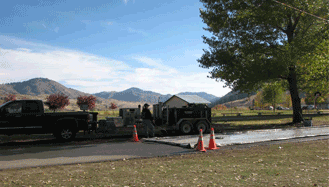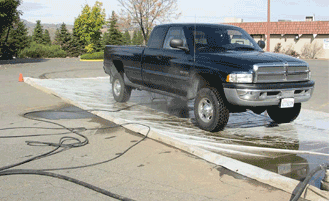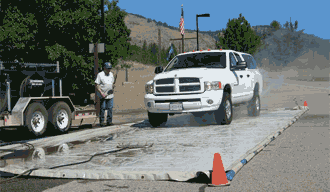

The WB 500 is specifically designed to remove and capture noxious weed seeds and plant particles from equipment and vehicles, while reclaiming, cleaning, and reusing the on-board water supply.

2006 Fire Season
Tripod Fire Complex
Okanogan County,
Washington S. and Polalie Fire Cle Elum, Washington St.
Hunter Education Day 2006
Okanogan County
Noxious Weed Control Board
Border Crossing
Okanogan County, WA and British Columbia, Canada
Project Site: DNR Fire: Rattlesnake Fire Complex. July 2-6, 2008 I have examined the four plant debris samples sent to me on July 9, 2008. The amount of debris received for review is as follows: 7/3/08 Sample - 90 grams, 7/4/08 Sample - 85 grams, 7/5/08 Sample - 85 grams, and 7/6/08 Sample - 245 grams for a total of 505 grams. As requested, I specifically looked for seed of the following noxious weed species in each sample: diffuse knapweed, Dalmatian toadflax, rush skeletonweed, leafy spurge and yellow starthistle. Of these species, only diffuse knapweed was found and identified in all four samples. The knapweed was found in the form of individual seeds and more commonly as intact mature and immature seed heads.
The samples also contained seed of many other plant species. Weedy introduced species found in all samples included Amaranthus sp. (pigweed), Polygonum sp. (knotweed), Brassica sp.(mustard), and Bromus sp. (downy and cheat.)
Weedy species found in some but not all samples included Dactylis (orchardgrass), Poa (bulbous bluegrass), Avena (wild oat), Setaria (foxtail), Verbascum (mullein), Plantago (plantain), Erodium (redstem filaree), Tragopogon (salsify), Onopordum (Scotch thistle), and Chenopodium (lambsquarters.) Two crop species, Avena (wheat) and Secale (rye), were found in several samples.
Seed from native plant species were identified from the following genera: Achillea (yarrow), Erigeron (daisy), Purshia (bitterbrush), Lithospermum (stoneseed), Ranunculus (buttercup), Lupinus (lupine), Eriogonum (buckwheat), Rubus (bramble), Lomatium (biscuit-root), Pinus (pine) and Alnus (alder.)
Many seeds present in the samples were not identifiable due to the fragmented and deteriorated condition of the seed. Because the seed size of the target noxious weed species is 1mm or larger, the fraction of sample material less than 1mm was not examined. It is highly likely that this fraction will also contain additional very small seed.
Please let me know if you have questions or if I can be of further assistance in your research. Sincerely, Denise Horton
USFS Okanogan-Wenatchee National Forest now requires weed wash systems on all fire incidents.
Weed wash systems are utilized as a check in station as part of "Mob in and De-Mob). Every vehicle and equipment must get processed through the weed wash system prior to them going to the fire line, to prevent new introductions of noxious weeds that are on their vehicle and equipment that is from another County, State or that has just arrived from another fire incident. When they de-mob they must get processed again to keep whatever noxious weeds they have collected from the fire area, on that particular site. Basically keep what is here, here and prevent them from being introduced at another fire incident or taking them home.
S-K Environmental utilizes a tag system to identify the vehicles that have been processed, records fire numbers and license plates and also records amount of debris collected and takes pictures.
When S-K Environmental is released from fire incidents, a fire incident report is submitted to the Host Agency for their records. A report could include the following:
Colville Reservation: Manila Creek Fire over 20,000 acres burned. Approximately 173 vehicles/equipment processed though weed wash system during September 13-26, 2007. 2,462 pounds of sludge collected containing dirt, weed seeds and plant particles. Noxious weeds identified: Dalmatian Toadflax Diffuse Knapweed Spotted Knapweed


.
